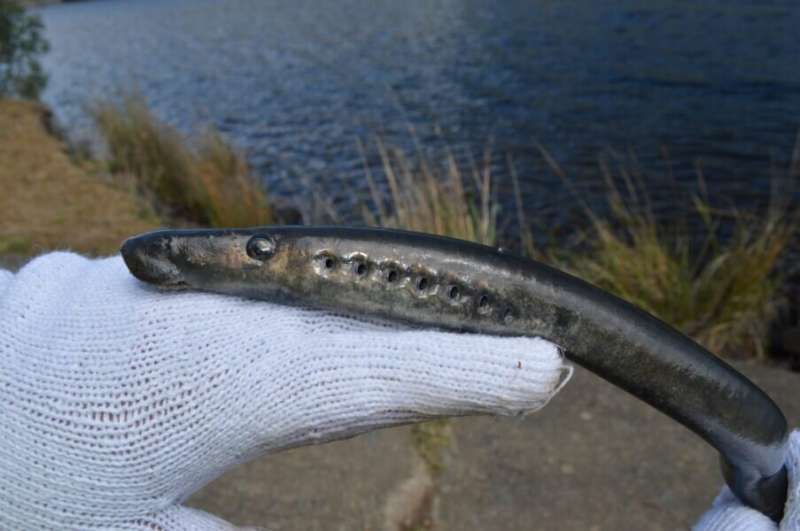This article has been reviewed according to Science X's editorial process and policies. Editors have highlighted the following attributes while ensuring the content's credibility:
fact-checked
trusted source
proofread
Bird diet sampling helps uncover secrets about the lives of lampreys

Researchers have discovered a flesh-eating fish is in major decline—by looking at the stomach content of some of the world's largest bird, albatrosses.
The Patagonian Lamprey, Geotria macrostoma, a parasitic species of an ancient order of jawless fish which, like eels and salmon, spend their early life in freshwater, migrate to the ocean for a year or more, and then return to rivers to spawn. Although lampreys are widespread across the globe, very little is known about the phase of their life cycles when they are in the ocean, particularly for the southern hemisphere species.
A new study, published in the journal Reviews in Fish Biology and Fisheries and led by British Antarctic Survey (BAS), has uncovered new secrets about these flesh-eating fish and their population around the sub-Antarctic from the stomachs of their predators, albatrosses.
By looking at the stomach contents, the team identified the first known lamprey hotspot in the open ocean, drastic changes in the lamprey populations, and vital clues about which animals transport or host these parasites.
The lampreys spawn in Argentinian river basins before migrating to coastal and open ocean waters where they attach to "host animals," feeding on their flesh through their suckered mouth. After feeding on their host, they detach and start to swim freely where they become prey for marine birds such as albatrosses.
Samples from the stomachs of gray-headed and black-browed albatrosses have been collected from as early as 1959 on Bird Island, South Georgia. The stomach contents are regurgitated by the birds, and the scientists then sort through the vomit, separating out the dietary components, including whole lamprey, teeth, and heads alongside the remains of other species of fish, squid and crustaceans.
By comparing the distributions of the two albatross species and those of other predators around South Georgia which don't eat lampreys, the team concluded that the lampreys are abundant in the Antarctic Polar Frontal Zone where the cold Antarctic waters meet the relatively warmer waters from the sub-Antarctic, not South Georgia as previously assumed. This is the first known hotspot in abundance of any lamprey species in oceanic waters.

Lampreys are parasites, and by comparing the abundance of different isotopes (types of atom of the same element) in the regurgitated lampreys with a range of other animals in the region, the team hoped to identify potential hosts. Although they could not identify likely candidates that were fishes, the isotope data seem to suggest the lampreys are potentially feeding on migrating baleen whales. Other circumstantial evidence included the timing of appearance of lamprey within the albatross diets—which coincides with whale migration in the region—and unexplained scars recorded on whales during the whaling era. The team suggest that the lampreys latch onto the whales as they head South before detaching when they reach the cold Polar Front where they turn from parasite to prey.
The team also concluded that there has been a sharp decline in the population of lampreys. In the mid-1970s, albatrosses consumed over 550 tons of lampreys each year. This is in stark contrast to the most recent decade when lampreys only made up a very small percentage of their diet. This likely indicates a major collapse in the lamprey population.
Professor Richard Phillips, a seabird ecologist at BAS and lead author of the study, says, "Our study reveals many insights into the fascinating biology of lamprey. Although our method of assessing their population size is unconventional—using albatrosses as samplers—our results suggest there has been a steep population decline, which is clearly a major conservation concern. There is a compelling case for listing of Patagonian lamprey at least as Near Threatened by the International Union for the Conservation of Nature, and an urgent need to better understand anthropogenic threats in Argentina."
Many lamprey species are in decline across the globe because of habitat loss, destruction, and obstruction of the river systems in which they breed. The Patagonian lamprey is particularly threatened by the construction of hydroelectric dams and the impacts of agriculture along waterways in the region.
The long-term decline in lampreys will have wide-reaching effects. Lampreys are rich in fats and energy, so a decline in their numbers is bad news for albatrosses which are themselves in decline due to mortality in fisheries and climatic change. The decline also has repercussions for the Argentinian river systems in which the lamprey breed as they provide vital nutrients to enrich the local ecosystem.
Allison Miller, a conservation geneticist at University of Otago and co-author of the study, says, "Southern Hemisphere lamprey species are important food sources for threatened species such as the yellow-eyed penguin—one of the rarest penguins in the world—fishery target species, and humans. In Chile, filoko are a traditional fishery for Mapuche who also see the fish as symbolic links, and in New Zealand kanakana/piharau are harvested annually by Māori. It is therefore crucial that we work together to conserve lampreys, given their importance for many animals, ecosystems, and cultures."
More information: Richard A. Phillips et al, Distribution, hosts and long-term decline in abundance of the Patagonian lamprey inferred from diet assessment of albatrosses, Reviews in Fish Biology and Fisheries (2023). DOI: 10.1007/s11160-023-09786-3
Provided by British Antarctic Survey


















